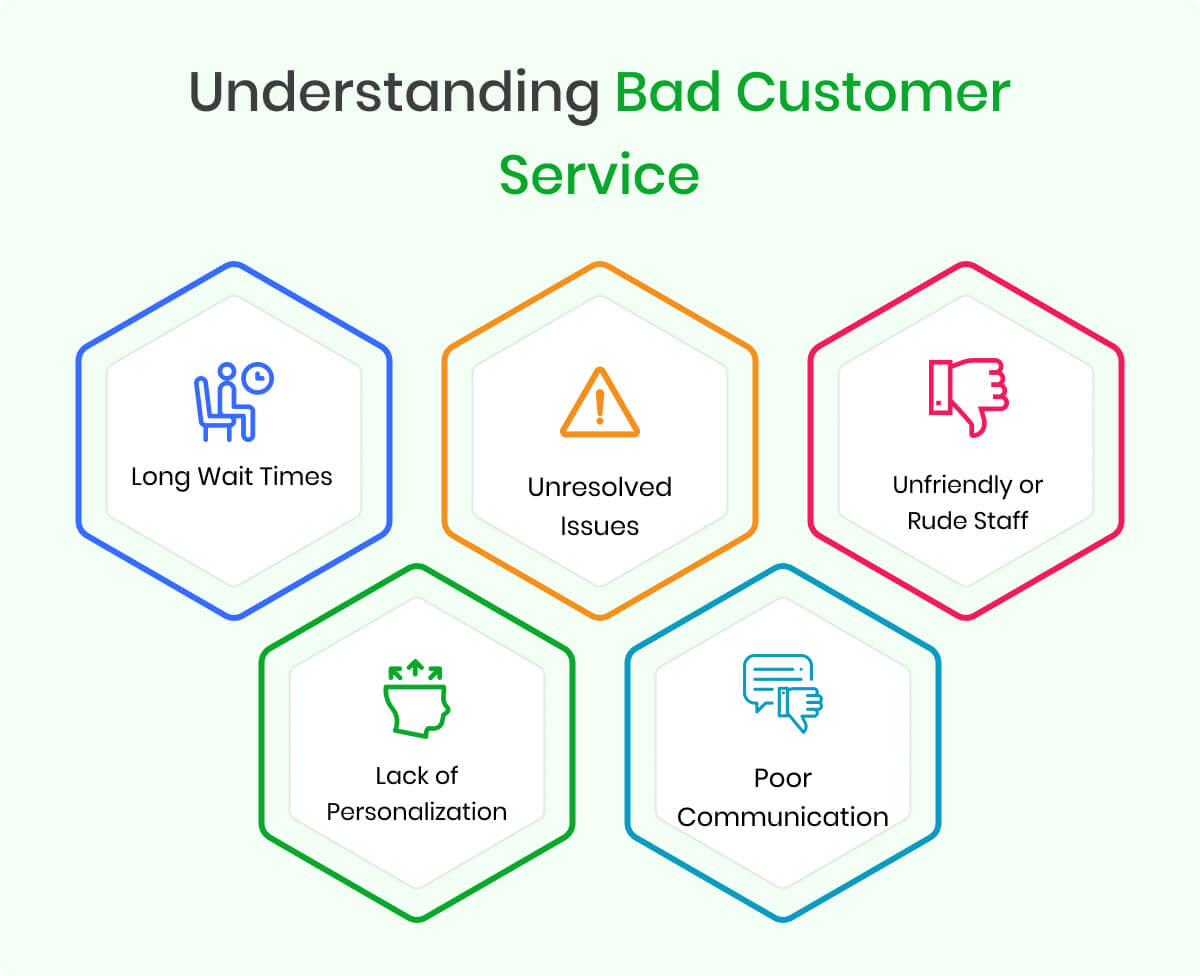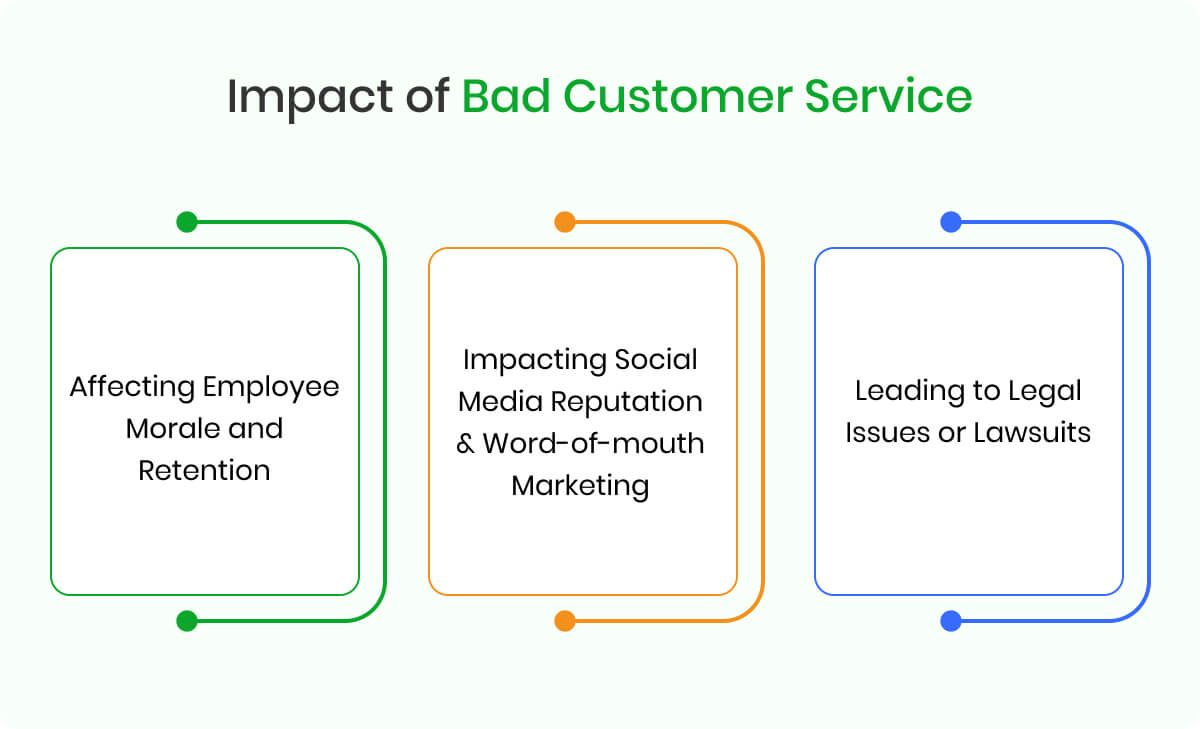 Customer Service
Customer Service

30 September, 2023

Imagine walking into a store, excited to make a purchase, only to be met with dismissive employees who seem more interested in their phones than in helping you. Far too many of us have experienced this scenario, and it’s a perfect example of the worst customer service.
While customers are the backbone of the business for a company, not all companies take customer service seriously. Some businesses have been known to provide the worst customer service imaginable. From long wait times to rude representatives, these companies have left their customers feeling unheard and unappreciated.
In this blog post, we’ll explore some of the worst customer service experiences customers have had to endure. We’ll take a closer look at what went wrong and how these companies could have done better. We will also discuss what you can do to avoid or deal with such situations in the future. Whether you are a consumer or a business owner, you will find this post interesting and informative.
Contents
Although there is no universal answer to what exactly bad customer service is, it can be defined as a series of actions and behaviors failing to satisfy the customer’s expectations or needs.

Different customers have different expectations and preferences when interacting with a business. It is considered bad customer service when the customer feels undervalued, frustrated, and dissatisfied with a business. Some common factors for bad customer service are:
With a view of these factors, businesses can find out where their customer service stands and bring necessary changes to improve their services.
Worst customer service can impact business in several ways. Customers unhappy with their experience are likely to share their dissatisfaction with others, online or offline.
This will discourage potential customers from buying from the business and damage the reputation and brand image. As a result, the business will have a hard time attracting and retaining loyal customers.

Here are some crucial factors bad customer service can result in
Dissatisfied customers may choose to take their business elsewhere. The cost of acquiring a new customer is significantly higher than retaining an existing one, making this a costly consequence.
As the market is highly competitive right now, it is very bad for businesses to lose even one customer.
In the age of social media and online reviews, bad news travels fast. One poor customer service experience can lead to negative reviews and bad word-of-mouth, damaging the company’s reputation.
Negative reviews and social media posts can quickly spread, influencing potential customer’s perceptions of the brand.
Consistently poor customer service can also impact employees’ morale and motivation, leading to decreased productivity and higher employee turnover.
When employees are forced to deal with dissatisfied customers or pick up the slack for poor service, it can lead to frustration and burnout. This, in turn, may result in higher turnover rates and a loss of top talent.
Providing bad customer service can create a vicious cycle. Dissatisfied customers may share their negative experiences, leading to further damage to the company’s reputation. As the reputation suffers, attracting new customers becomes more challenging, exacerbating financial losses.
As Warren Buffet said, “It takes 20 years to build a reputation and five minutes to ruin it.” Businesses must strive to provide excellent customer service to avoid these consequences. Remember, good customer service is not just about making a sale; it’s about building long-term relationships with customers that lead to loyalty and ongoing business.
To ensure customer satisfaction and loyalty, it is crucial for businesses to offer the best customer service possible. However, many businesses fail to offer it, even if they do not clearly understand good customer service.
So, here is a comparison table between good customer service and worst customer service to help you understand what to do and what to avoid:
| Characteristic | Good Customer Service | Worst Customer Service |
| Communication | Good customer service representatives actively listen to customers, empathize with their concerns, and provide clear and concise information. | Lack of effective communication can frustrate customers and leave them feeling unheard or undervalued. |
| Responsiveness | Promptly addressing customer inquiries, complaints, or feedback demonstrates a commitment to excellent service. Good customer service representatives prioritize timely responses. | Ignoring or delaying responses to customer inquiries or complaints can lead to dissatisfaction and a perception of indifference. |
| Personalization | Treating customers as individuals and tailoring interactions to their specific needs fosters a sense of importance and builds trust. | Failing to understand or acknowledge customers’ concerns can make them feel unimportant and unappreciated. |
| Product Knowledge | Well-informed customer service representatives can provide accurate information about products or services, helping customers make informed decisions. | Rude or dismissive behavior towards customers can severely impact their perception of a company and discourage future interactions. |
| Problem Resolution. | Resolving issues promptly and efficiently is crucial for good customer service. This includes taking ownership of problems and following up to ensure customer satisfaction. | In the worst customer service scenarios, problems may go unresolved or be handled in an unsatisfactory manner, leaving customers frustrated and dissatisfied. |
By comparing good and bad customer service, you can identify areas for improvement for your business and strive to deliver exceptional experiences that foster customer loyalty and satisfaction.
When customers interact with a business, they expect to be treated with respect, courtesy, and professionalism. However, not all businesses meet these expectations, even providing the worst customer service possible.
Here are some real-life examples of worst customer service from different industries, along with the sources and links.
One of the most frustrating experiences for customers is dealing with cable TV providers. A common complaint is the lack of empathy and understanding from customer support representatives. Customers often face long wait times, unhelpful automated phone prompts, and being transferred multiple times.
Comcast, the television provider, was voted the worst-rated company for customer service in the United States in 2020, receiving the largest share of negative responses (44 percent).
One of the reasons for this poor rating is their habit of canceling customers’ service without their permission or knowledge. For example, in 2019, a customer named Lisa Brown tried to downgrade her cable package to save money. Instead of honoring her request, Comcast canceled her entire service and sent her a final bill of $60. (Source)
When she called Comcast to complain, they told her that she had requested the cancellation herself, which was not true. They also refused to reinstate her service unless she paid a $180 reconnection fee.
How to fix it:
A prime example of appalling customer service is United Airlines’ failure to sufficiently apologize for dragging a customer out of his seat using brute force in 2017. When United overbooked this particular flight, they asked passengers to give up their seats to accommodate flight attendants.
When no one volunteered, they randomly selected four passengers to be removed from the plane. One of them was Dr. David Dao, a physician who refused to leave his seat because he had patients to see the next day.
Security officers then violently dragged him out of his seat, causing him to suffer a concussion, a broken nose, and two lost teeth. Other passengers captured The incident on video, which went viral on social media, sparking outrage and boycotts.
United Airlines initially issued a vague statement that did not apologize to Dr. Dao or acknowledge the excessive use of force. The CEO of United Airlines, Oscar Munoz, also defended the employees’ actions and called Dr. Dao “disruptive and belligerent” in an internal memo. After three days of public backlash, Munoz finally apologized to Dr. Dao and promised to review the company’s policies and procedures.
How to fix it:
Wells Fargo, the banking giant, was involved in one of the biggest scandals in financial history in 2016. The company admitted to opening millions of fake accounts for customers without their consent or knowledge to meet aggressive sales targets and earn bonuses.
The fake accounts resulted in customers being charged fees and interest, as well as affecting their credit scores and identity theft risks. The company also fired thousands of employees who were involved in or reported the fraud.
Wells Fargo initially denied any wrongdoing and blamed the rogue employees for the misconduct. The CEO of Wells Fargo, John Stumpf, also refused to take responsibility or resign from his position.
It was only after facing public outrage, regulatory investigations, lawsuits, and congressional hearings that Wells Fargo apologized to the customers and agreed to pay $185 million in fines and $5 billion in restitution. Stumpf also stepped down as CEO and forfeited $41 million in compensation.
How to fix it:
Apple, the technology giant, faced a backlash in 2017 when it was revealed that it had deliberately slowed down the performance of older iPhone models without informing or asking the customers.
The company claimed that it did this to prevent unexpected shutdowns caused by aging batteries. Still, many customers suspected that it was a way to force them to upgrade to newer and more expensive models. The company also charged customers $79 to replace their batteries, even if they were still under warranty.
Apple initially denied any wrongdoing and defended its actions as a feature, not a bug. The company also refused to acknowledge the customers’ complaints or offer them any solutions. Only after facing public criticism, media scrutiny, and legal actions did Apple apologize to the customers and admit that it could have been more transparent about its practices.
The company also reduced the battery replacement fee to $29 and introduced a software update that allowed customers to monitor their battery health and disable the performance throttling.
How to fix it:
The retail industry relies heavily on attracting and retaining customers with quality products and services. This makes the industry one of the most competitive and customer-oriented sectors in the economy.
However, not all retailers deliver good customer service; some even provide terrible experiences, making customers dissatisfied, frustrated, or angry. Walmart is one of the retail chains that holds a reputation for poor customer service.
The company has been criticized for its low wages, poor working conditions, and unethical practices that affect its employees and customers.
A customer in Texas was denied a refund for a defective product because he did not have the original receipt. The customer had bought the product online and had the confirmation email, but the store manager refused to accept it as proof of purchase. The customer had to contact Walmart’s corporate office to get his refund.
Another customer in Florida was humiliated by a cashier who made fun of her food stamps. The cashier loudly announced to the other customers in line that the customer was using food stamps and asked her if she was too lazy to work. The customer felt embarrassed and left the store in tears.
Also, in California, a customer was injured by a falling display shelf that collapsed on him. The shelf was overloaded with heavy items and was not properly secured. The customer suffered a concussion and a broken arm and had to be taken to the hospital. Walmart was sued for $10 million after the incident.
How to fix it:
One of the worst customer service examples in the hospitality industry comes from Airbnb, a platform that connects hosts and guests for short-term rentals.
In 2016, a guest named Jacob Lopez booked a room in Madrid, Spain, through Airbnb. He claimed that he was sexually assaulted by his host, who had a knife and threatened to kill him if he resisted.
He managed to escape and contacted Airbnb for help. However, instead of providing him with immediate assistance and support, Airbnb asked him to sign a non-disclosure agreement (NDA) that would prevent him from speaking publicly about the incident or suing the company. He refused to sign the NDA and went to the media to expose Airbnb’s mishandling of his case.
This example shows how Airbnb failed to provide adequate customer service to a guest who had experienced a traumatic event. Not only did they not offer him any compensation or apology, but they also tried to silence him and protect their own reputation.
How to fix it:
From the discussion above, it is clear that poor customer service can bring devastating consequences for your business. But what are the common reasons for poor customer service? And how can you avoid them?
Here are 7 possible causes and solutions:
One of the main reasons for worst customer service is the lack of training and education of the staff members interacting with the customers. Suppose the staff members are not properly trained in product or service knowledge, communication, problem-solving, and customer service etiquette.
In that case, they may not be able to answer the customers’ questions, address their concerns, or resolve their issues effectively and efficiently. This can lead to customer dissatisfaction, frustration, and complaints.
How to avoid this:
Another reason for worst customer service is the lack of resources and tools that the staff members need to provide effective and efficient customer support and assistance.
If the staff members do not have access to adequate resources and tools, such as computers, phones, internet, software, databases, or inventory systems, they may not be able to perform their tasks smoothly and quickly. This can lead to customer frustration, impatience, and dissatisfaction.
Also, employees who are understaffed, overworked, or under-equipped may not be able to provide timely and quality service to customers. They may also feel stressed, burned out, or demotivated.
How to avoid this:
Business owners need to provide clear and consistent guidelines on how to deliver customer service to their employees. Employees may also have different interpretations of what constitutes good service or how to deal with difficult situations.
Employees who do not receive regular and constructive feedback from their managers, peers, or customers may need to learn how to improve their service or what they are doing well. They may also feel unappreciated, ignored, or criticized.
How to avoid this:
The staff members ‘ lack of empowerment and autonomy can be a significant reason for the worst customer service. Employees who do not have the authority or autonomy to make decisions or solve customer problems may be unable to provide satisfactory service.
They may also feel frustrated, helpless, or dependent on others. They may also have to follow rigid rules or procedures that may not suit the customers’ needs or preferences. This can lead to customer dissatisfaction, disappointment, or resentment.
How to avoid this:
Employees who share a different vision, mission, or values than the business may be unable to provide consistent and authentic customer service. They may also feel disconnected, conflicted, or indifferent about the business goals or culture.
How to avoid this:
One of the severe reasons for poor customer service is the lack of communication and coordination among the staff members who are involved in providing support and assistance to the customers.
If the staff members do not communicate or coordinate with each other effectively and efficiently, they may create confusion, inconsistency, or duplication of work. They may also miss important information or details that can affect the quality or timeliness of their service.
How to avoid this:
Bad customer service has adverse effects on your business reputation, customer loyalty, and revenue. It can also lead to increased complaints, refunds, and legal issues.
To avoid bad customer service, you need to focus on two main aspects: measuring and improving customer service quality and performance and training and motivating the customer service team.
Let’s discuss them in detail:
To ensure that your customer service meets your customer’s expectations, you need to measure it regularly and objectively. Some of the metrics that you can use are:
By tracking these metrics over time, you can identify the areas where your customer service needs improvement. You can also use them to set goals and incentives for your customer service team.
Your customer service team is the face of your business. They need to have the skills, knowledge, and attitude to deliver excellent service to your customers.
To achieve this, you need to invest in their training and motivation. Some of the ways that you can do this are:
Following these tips can avoid bad customer service and enhance your customer experience. This will help you retain your existing customers, attract new ones, and grow your business.
Bad customer service can damage your business’s reputation within a minute. You will lose customers and revenue left and right solely because of it. In this blog post, I have discussed what bad customer service is, how it affects your business, and how to avoid it.
I hope this blog post has helped you understand the importance of good customer service and how to provide it to your customers.
Good customer service is not only a competitive advantage but also a way to build trust, loyalty, and satisfaction among your customers. Remember, the customer is always right, and you should strive to exceed their expectations.